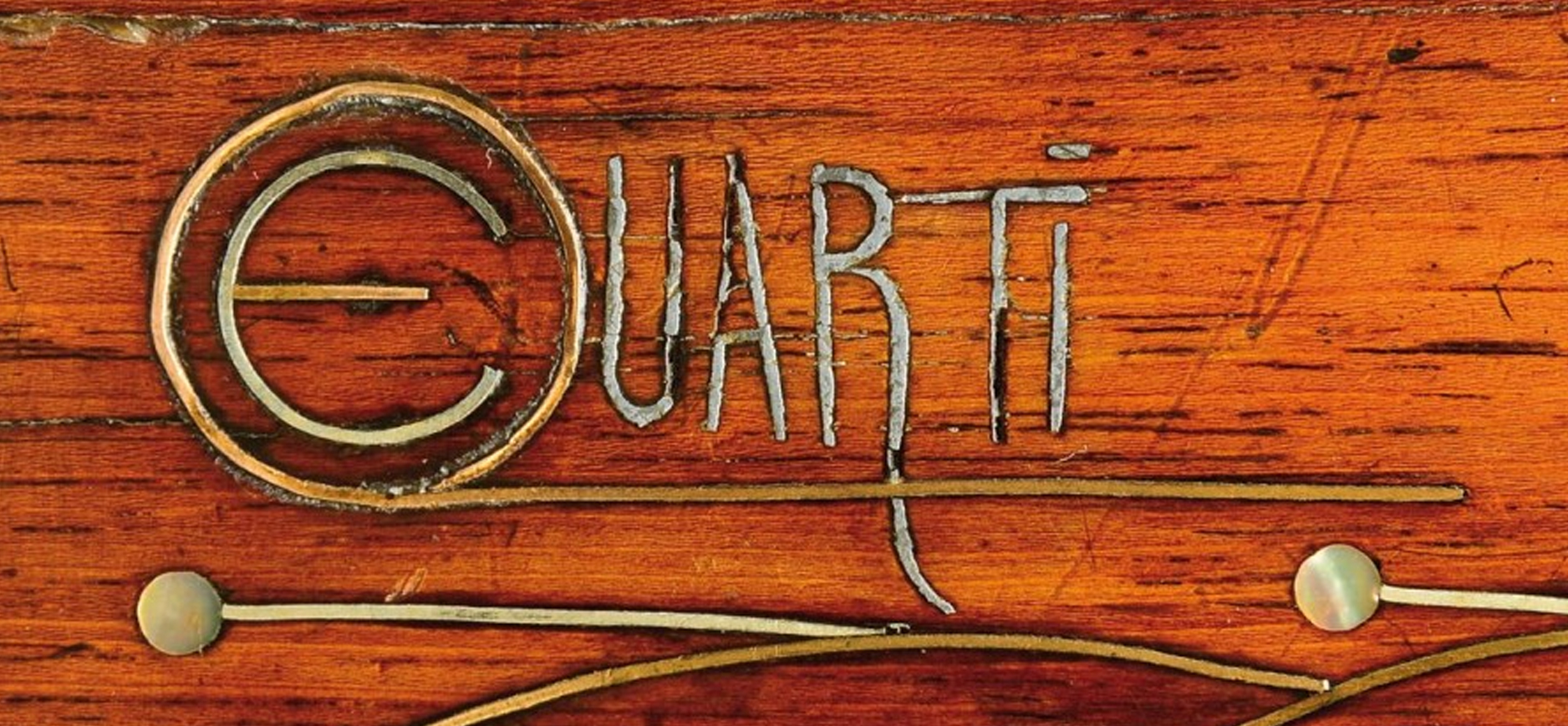Eugenio Quarti, the “prince of cabinetmakers”

Eugenio Quarti, “prince of cabinetmakers,” was born in 1867 in Villa d’Almè, a small town in the province of Bergamo, into a family dedicated to woodworking.
 At the age of 14, he was sent by his father to Paris, where he worked as an apprentice in a cabinetmaking workshop. In the late 1880s, he returned to Italy and settled in Milan, where he worked for a short period with Carlo Bugatti.
At the age of 14, he was sent by his father to Paris, where he worked as an apprentice in a cabinetmaking workshop. In the late 1880s, he returned to Italy and settled in Milan, where he worked for a short period with Carlo Bugatti.
In the same year, he opened his own workshop on Via Donizetti.
The first furniture pieces he designed and produced clearly show Bugatti’s influence.
 From 1894, the year he participated in the International Exhibition in Antwerp and the International Worker’s Exhibition in Milan, until 1898, Eugenio Quarti developed his own idea of modernist furniture design, thanks to the encouragement of Vittore Grubicy, freeing himself from the stylistic influences of Bugatti and finding new forms that defined a completely personal style. In the same year, he participated in the Turin exhibition, presenting modernist-style furniture made of predominantly dark wood, decorated with “inlaid” metal, ivory, tortoiseshell, and mother-of-pearl; by now, he was completely liberated from past stylistic constraints, establishing himself as an artist with a unique and defined personality.
From 1894, the year he participated in the International Exhibition in Antwerp and the International Worker’s Exhibition in Milan, until 1898, Eugenio Quarti developed his own idea of modernist furniture design, thanks to the encouragement of Vittore Grubicy, freeing himself from the stylistic influences of Bugatti and finding new forms that defined a completely personal style. In the same year, he participated in the Turin exhibition, presenting modernist-style furniture made of predominantly dark wood, decorated with “inlaid” metal, ivory, tortoiseshell, and mother-of-pearl; by now, he was completely liberated from past stylistic constraints, establishing himself as an artist with a unique and defined personality.
Fine woods such as teak, mahogany, rosewood, maracaibo, Indian walnut, natural or tinted maple, were enriched with delicate inlays, metal filaments, and precious materials, arranged to emphasize the profiles, within which decorative motifs of plants or stylized animals were incorporated.
In 1900, he participated in the International Exhibition in Paris, where he received the prestigious “Grand Prix” from the jury.
On his way to undisputed success, his clientele grew increasingly among the aristocracy and high bourgeoisie; the furniture he produced became ever more luxurious and very expensive.
After leaving his workshop on Via Donizetti, he opened a new 100-square-meter workshop on Via Palermo, where he remained until 1904.
From this point on, Eugenio Quarti, who exclusively produced individual pieces to be incorporated into already finished furniture settings, began producing entire environments that were often complex and grand.
 At the end of 1904, Quarti moved to a new factory designed by Luigi Conconi on Via Carlo Poma. Here, gradually and with an entrepreneurial approach typical of the time, he began a production aimed at gradually expanding his clientele; alongside luxurious and precious furniture, he also began offering more affordable and mass-produced items.
At the end of 1904, Quarti moved to a new factory designed by Luigi Conconi on Via Carlo Poma. Here, gradually and with an entrepreneurial approach typical of the time, he began a production aimed at gradually expanding his clientele; alongside luxurious and precious furniture, he also began offering more affordable and mass-produced items.
From 1906, he introduced geometric elements, checkered inlays, and light and dark semicircles in wood or glass, clearly reminiscent of Viennese style. After the first decade of the century, he designed furniture for important Milanese homes and for the Camparino bar in Galleria Vittorio Veneto II, where in 1923, he replaced the old Empire-style furniture with his own creations. This was a deep and significant restyling operation that involved close collaboration with Angiolo d’Andrea and Alessandro Mazzuccotelli.
He passed away six years later, leaving the management of the company to his son Mario (1901-1974), who inherited the business and restructured it. In the 1930s, the “Quarti – Mobili d’arte” company employed around 200 people.
Without a doubt, Eugenio Quarti, one of the great Italian cabinetmakers of the 20th century, worked with the most prestigious architects of his time.
Giuseppe Sommaruga, Luigi Broggi, Alfredo Campanini, just to name a few.
He also worked as a decorator, designing entire furniture sets for both public and private palaces. He was the one who designed the furnishings for Palazzo Castiglioni in Milan, Villa Carosio in Baveno, the Grand Hotel and Casino in San Pellegrino Terme, and the Hungaria Palace Hotel at the Lido of Venice. He also took on less significant commissions, such as the furniture for Villa Mariani in Bordighera, the residence of the painter Pompeo Mariani.
In addition to his work as a cabinetmaker and later as a decorator, he also engaged in teaching and became the director of the applied arts laboratory for the woodworking industry at the Società Umanitaria.
The furnishing proposed shows, in our opinion, the classic and most prominent features of Quarti’s cabinetmaking production, post-1904, perfectly fitting his entrepreneurial approach to creating complete and more accessible furniture sets for a wider clientele.
However, it retains clear Quarti-style elements from his most famous and awarded works. For example, the so-called *coup de fouet*, outlined in maple, reminiscent of that on the music cabinet (exhibited in Turin in 1902) and featured in *Il mobile Liberty italiano* by Irene de Guttry / Maria Paola Maino, Page 185, Fig.13; or the floral inlays, always in light wood, with broad petals similar in style and technique to those on the public room furniture published in *Il mobile del novecento* by Degrada, Gualdoni Ed. De Agostini, Page 75. (Also exhibited in Paris in 1900 and later in Turin in 1902).
In general, there are obvious similarities with the specific stylistic features undoubtedly characteristic of Quarti; one can recognize them in the great skill and artistry of the floral inlays with broad petals, the delicate inlays following the natural grain of the wood, the simple but refined lines, and the graceful curves accentuated by the insertion of fine brass inlays (which were also part of the signature style with which the cabinetmaker would autograph his most important pieces), which he referred to as “inlays,” and in general, in the great finesse of the entire furnishing, where uncommon blue lacquer decorations stand out.







